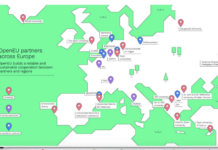Huessner, K. M. (2012) 5 ways online education can keep its students honest Gigaom, November 17
This useful article lists a range of tools that can be used to prevent cheating in online learning. The article puts them into five categories:
- remote live proctoring, using web cams and humans monitoring several screens
- remote web proctoring, using web cams that record, so instructors can check later if they are suspicious of a student’s results
- browser lockdowns, which prevent students looking up things during an exam
- keystroke pattern recognition, which analyzes patterns of keynote pressure (99% accurate in identify individuals using a computer keyboard)
- plagiarism detection software.
The article provides links to companies providing each of these services.
Comment
None of these is perfect on its own, particularly if someone else is in the room where the student is taking the exam but is not identified.
To this list can be added test centres, where students have to identify themselves and take exams with live proctors. These may be either through collaboration between public institutions such as local colleges or even libraries within the same state or province, or through commercial test centres, such as Pearson’s.
However, human factors are still probably the best way to prevent cheating. Some of these include:
- continuous assessment: students provide regular work that is assessed, so the instructor gets to know the student. Any big changes between continuous and final assessment can then be checked out. E-portfolios are a good example of a tool that can be used for continuous assessment.
- setting exam questions where it is hard to cheat, for instance by requiring student to relate their learning to their specific context, such as a project. Every student then has to submit original work. It is much easier to get away with cheating on multiple-choice questions than it is on an original essay.
- getting to know students online, through their participation in online discussions, and through personal feedback.
Coursera-style MOOCs have focused more attention on technologies that prevent cheating. Coursera-style MOOCs try to avoid these ‘human factor’ issues, because they are more costly, but while the anti-cheating technologies can be helpful, they are not yet sufficient in themselves to provide confidence that the person being examined has done the work. The problem with technology solutions is that there is always a technological way around the solution.
Cheating is often the result of a poor educational process or experience. Once again, this comes down to the distinction between learning as transferring information vs learning as a developmental process. If, as I do, you believe education is a developmental process, it is the student in the end who loses from cheating, because they have missed the point of the exercise, which is self development and growth.
See also:
Infographic on cheating in online learning










 Dr. Tony Bates is the author of eleven books in the field of online learning and distance education. He has provided consulting services specializing in training in the planning and management of online learning and distance education, working with over 40 organizations in 25 countries. Tony is a Research Associate with Contact North | Contact Nord, Ontario’s Distance Education & Training Network.
Dr. Tony Bates is the author of eleven books in the field of online learning and distance education. He has provided consulting services specializing in training in the planning and management of online learning and distance education, working with over 40 organizations in 25 countries. Tony is a Research Associate with Contact North | Contact Nord, Ontario’s Distance Education & Training Network.


This has definitely been an issue that I’ve struggled with in moving some of my assessments online–the worry or wonderment of if students are actually doing the work themselves, but I have found that by getting to know the students’ individual writing styles (luckily I have small classes of approximately 15 students), it can be blatantly obvious if they’ve had “help” and also having application-based online assessments makes it much more difficult for the students to cheat.
[…] Tony Bates on cheating: ”Cheating is often the result of a poor educational process or experience. Once again, this comes down to the distinction between learning as transferring information vs learning as a developmental process. If, as I do, you believe education is a developmental process, it is the student in the end who loses from cheating, because they have missed the point of the exercise, which is self development and growth.” […]
[…] Technology for Teachers: 9 Ways Students Can Host Peer Tutoring Sessions Online Sort Share tonybates.wpengine.com 2 months […]